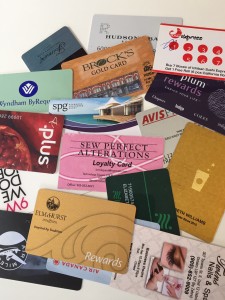This is a photo of the collection of so-called loyalty cards I can currently find. There are many more tucked into purses, pockets, passport folders, glove compartments and desk drawers.
I have countless others in the virtual world, and I don’t think a week goes by that I’m not asked to join someone’s customer reward program.
And yet, as I gaze upon my assortment of cards, I realize that I’m not actually loyal to most of them; I’m just a well-trained harbour seal.
Make a purchase, get a herring. Get enough points, get some money off another purchase, earn more herring. That’s not loyalty, in my books – it’s a habit, perhaps just a reflex, and that’s okay — but let’s not confuse Herring Buckets with loyalty.
At Seaworld, the minute the fish bucket goes away, that seal is not jumping through hoops or pretending to kiss anything. It’s going back into its tank to ponder how it came to be so manipulated.
Friends, loyalty is not something we buy and manage programmatically; it’s something we earn and invest in and hone and learn from. It’s the result of a countless number of really great experiences, flawless executions, satisfying conversations and being made to feel terrific.
One place I don’t have a loyalty card is at my local shoe store. I’ve been buying shoes for myself and my kids at this family-owned shop for almost 20 years, and I’m rabidly loyal. I can buy my runners and soccer boots and the kids’ snow boots elsewhere for a lot less, but I won’t. That’s the definition of loyalty, incidentally.
I’m loyal because John, the owner, greets me and my kids by name. He takes the time to fit our shoes properly and won’t dream of letting us leave in anything that doesn’t fit perfectly. He’ll take it back if we need him to, and when I pay, he always knocks ten or 15 percent (sometimes more) off the price. Then he looks me in the eye, shakes my hand and thanks me for my business. That’s way nicer than the little stamp I get at the manicure place. He does this dozens of times a day, six days a week, all year long. Not a bucket of fish in sight.
Those of you who have been hanging around this blog for any length of time will recall that I have a completely irrational loyalty to Fairmont hotels. (full disclosure, I also have a Herring card with them) Sure, there are newer, more modern hotels with mood-altering lights and wonderful food and fast wi-fi, but at Fairmont, there is this baseline of formality and civility that I just don’t find in other places. They may not shake my hand or give me a discount when I leave, but I walk in and out feeling like a much more important person than I really am. For that, I will put up with plumbing noises, the odd draft and tiny gyms. Most telling of all, if they took away my Herring card, I’d still stay there.
This brings me to the interesting bit of this. I’m worried that companies are investing in their Herring Bucket programs as a way to drive repeat business instead of investing in the things that drive true loyalty: great products, terrific systems, brilliant customer service, trained staff, exquisite experiences and gratitude.
I don’t know if such models exist, but I’d be interested in knowing what the real revenue impact is of cancelling a Herring Bucket program. Here in Canada, Rogers has just announced it is exiting the fish business, mostly because nobody participated in it, but also, I suspect, because they couldn’t actually connect it to revenue.
Marketers ought to be looking at this too. How much of your budget is allocated to marketing a rewards program, versus whatever it is you sell or do? What could you do with that budget if you didn’t use it to promote a bucket of fish?
I think Herring Buckets have a place in the market, probably they are a great way to attract first-time customers or to upsell people into a program, but we need to be very careful that we don’t confuse a hankering for herring with actual preference.
As you can tell by the tragic number of cards in the photo, I don’t say no to offers of reward programs as often as I should, and I will admit that I have been cashing in points and miles and things for years, quite happily, thank you.
Let’s not suggest that my abundant wealth of points and little stamps are symptoms of loyalty. I have no loyalty to the places where I buy my gas, my shampoo or my liquor. I have an ongoing need for these things and I base my preference for where I purchase them on my Herring Bucket benefits. Change the Herring provider, change the habit. No loyalty there, until someone makes me feel like a million bucks.
Related Posts
Border Collies are Loyal; Customers are Satisfied
The End of Valued Customers
Interesting Things I Found This Week
In a departure from the usual horribleness of wireless carrier advertising, T-Mobile’s Binge On campaign which broke in November, is kind of fun. Plus it has Aaron Paul in it. You can see one of them here.
Tom Koletas has great news for the data marketers out there. 2016 is the year Big Data gives B2B a bit of sugar. You read it here first. Well, second.
BizMarketer is written by Elizabeth Williams
I help companies have better conversations
Drop me a line at ewilliams@candlerchase.com
Or follow me @bizmkter
Excellent post! We could only wish that enterprises large and small would invest in the things that would inspire real loyalty. We (vendors and customers alike) spend way too much of our time and attention on lip service and trappings!